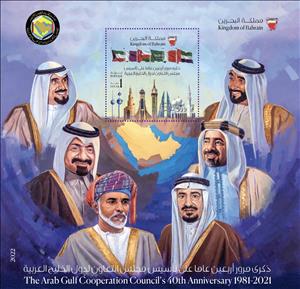Souvenir Sheet: Gulf Cooperation Council, 40 Years (Bahrain 2022)
Gulf Cooperation Council, 40 Years (Bahrain 2022)
26 December (Bahrain ) within release Gulf Cooperation Council, 40 Years (2022) goes into circulation Souvenir Sheet Gulf Cooperation Council, 40 Years face value 1 Bahraini fils
| Souvenir Sheet Gulf Cooperation Council, 40 Years in catalogues | |
|---|---|
| Colnect codes: | Col: BH 2022.12.26-02 |
Souvenir Sheet is square format.
Also in the issue Gulf Cooperation Council, 40 Years (2022):
- Stamp - Gulf Cooperation Council, 40 Years face value 500;
- Full Pane - Gulf Cooperation Council, 40 Years face value 8*500;
- Souvenir Sheet - Gulf Cooperation Council, 40 Years face value 1;
- Stamp - Gulf Cooperation Council, 40 Years face value 1;
Souvenir Sheet Gulf Cooperation Council, 40 Years it reflects the thematic directions:
Diplomacy is the main instrument of foreign policy which represents the broader goals and strategies that guide a state's interactions with the rest of the world. International treaties, agreements, alliances, and other manifestations of international relations are usually the result of diplomatic negotiation and processes. Diplomats may also help shape a state by advising government officials.
A flag is a piece of fabric (most often rectangular or quadrilateral) with a distinctive design that is used as a symbol, as a signaling device, or as decoration. The term flag is also used to refer to the graphic design employed, and flags have since evolved into a general tool for rudimentary signalling and identification, especially in environments where communication is similarly challenging (such as the maritime environment where semaphore is used). National flags are patriotic symbols with varied wide-ranging interpretations, often including strong military associations due to their original and ongoing military uses. Flags are also used in messaging, advertising, or for other decorative purposes. The study of flags is known as vexillology, from the Latin word vexillum, meaning flag or banner.
A head of state (or chief of state) is the public persona that officially represents the national unity and legitimacy of a sovereign state. In some countries, the head of state is a ceremonial figurehead with limited or no executive power, while in others, the head of state is also the head of government. In countries with parliamentary governments, the head of state is typically a ceremonial figurehead that does not actually guide day-to-day government activities and may not be empowered to exercise any kind of secular political authority (e.g., Queen Elizabeth II as Head of the Commonwealth). In countries where the head of state is also the head of government, the president serves as both a public figurehead and the actual highest ranking political leader who oversees the executive branch (e.g., the President of the United States).
A joint issue is the release of stamps or postal stationery by two or more countries to commemorate the same topic, event or person. Joint issues typically have the same first day of issue and their design is often similar or identical, except for the identification of country and value.A monument is a type of structure that was explicitly created to commemorate a person or event, or which has become relevant to a social group as a part of their remembrance of historic times or cultural heritage, due to its artistic, historical, political, technical or architectural importance. Examples of monuments include statues, (war) memorials, historical buildings, archaeological sites, and cultural assets. If there is a public interest in its preservation, a monument can for example be listed as a UNESCO World Heritage Site. The Palgrave Encyclopedia of Cultural Heritage and Conflict gives the next definition of monument:





